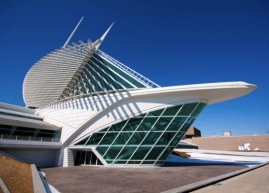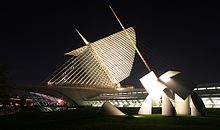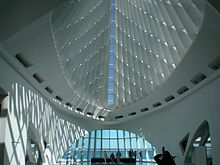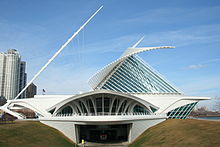#35. The Milwaukee Art Museum

Milwaukee Museum of Art
The Milwaukee Art Museum is a worl class example of modern art, both inside and out. An incredible feature is the animated Burke Brise Soleil wings.The Spanish designer Santiago Calatrava has given Milwaukee, Wisconsin a one-of-a-kind example of modern architecture.
 The Milwaukee Art Museum Location: Milwaukee, Wisconsin Architect: Santiago Calatrava Year: 2001
The Milwaukee Art Museum Location: Milwaukee, Wisconsin Architect: Santiago Calatrava Year: 2001
The link to Saarinen here is that Eero is responsible for the building next to Calatrava’s monumental winged Milwaukee Museum of Art. Like the Gate Way Tower, the building gives a Midwestern town a world-renowned architectural gem. Different, however, is that the wings of the Milwaukee Art Museum move over Windhover Hall.
The Milwaukee Art Museum (MAM) is an art museum with a collection of over 30,000 works of art serving over 350,000 visitors a year. The campus of three buildings is located on Lake Michigan in Milwaukee, Wisconsin. The Museum’s stated mission is to “collect and preserve art, presenting it to the community as a vital source of inspiration and education.”
The Milwaukee Art Museum from the north at night
The 341,000-square-foot (31,700 m2) Museum includes the War Memorial Center (1957) designed by Finnish-American architect Eero Saarinen, the Kahler Building (1975) by David Kahler, and the Quadracci Pavilion (2001) created by Spanish architect Santiago Calatrava. The Reiman Bridge, also designed by Calatrava, connects to the pavilion and provides pedestrian access to and from downtown Milwaukee.
From its roots in Milwaukee’s first art gallery in 1888, the Museum has grown today to be an icon for Milwaukee and a resource for the entire state.
The Museum offers works in various permanent Collection galleries, as well as a variety of changing special exhibitions throughout the year.
History
Interior of the Milwaukee Art Museum
Beginning around 1872, multiple organizations were founded in order to bring an art gallery to Milwaukee, as the city was still a growing port town with little or no facilities to hold major art exhibitions. Over the span of at least nine years, all attempts to build a major art gallery had failed. In 1881, exhibitions were held at Milwaukee’s Exposition Hall, which was Milwaukee’s primary event venue at the time. Shortly after that year, Alexander Mitchell donated all of her collection into constructing Milwaukee’s first permanent art gallery in the city’s history.
In 1888, the Milwaukee Art Association was created by a group of German panoramaartists and local businessmen. The same year, British-born businessman Frederick Layton built, endowed, and provided artwork for the Layton Art Gallery. In 1911, the Milwaukee Art Institute, another building constructed to hold other exhibitions and collections, was completed. The institute was built right next to the Layton Art Gallery. Alfred George Pelikan, who received his Masters in Fine Arts (MFA) from Columbia University, was the Director of the Milwaukee Art Institute from 1926 to 1942.
The Milwaukee Art Center (now the Milwaukee Art Museum) was formed when the Milwaukee Art Institute and Layton Art Gallery merged their collections in 1957 and moved into the newly built Eero Saarinen-designed Milwaukee County War Memorial.
The Art Collection
The Milwaukee Art Museum from the south
The museum is home to over 35,000 works of art housed on four floors of over forty galleries with works from antiquity to the present. Included in the Collection are 15th– to 20th–century European and 17th– to 20th–century American paintings, sculpture, prints, drawings, decorative arts, photographs, and folk and self-taught art. Among the best in the nation are the Museum’s holding of American decorative arts, German Expressionism, folk and Haitian art, and American art after 1960.
Important artists represented include Gustav Caillebotte, Nardo di Cione, Francisco de Zurbarán, Jean-Honoré Fragonard, Winslow Homer, Auguste Rodin, Edgar Degas, Claude Monet, Henri de Toulouse-Lautrec, Frank Lloyd Wright, Pablo Picasso, Joan Miró, Mark Rothko, Robert Gober, and Andy Warhol. The Museum also holds one of the largest collections of works by Wisconsin native Georgia O’Keeffe.
It also has paintings by these European painters: Francesco Botticini, Jan Swart Van Groningen, Ferdinand Bol, Jan Goyen, Hendrick Van Vliet, Franz Von Lenbach (“Bavarian Girl”), Ferdinand Waldmüller (“Interruption”), Carl Spitzweg, Christian Bokelman (“Broken Bank”), Bouguereau, Gerome (“2 Majesties”), Gustave Caillebotte, Camille Pissarro, Alfred Kowalski (“Winter in Russia”), Jules Bastien-Lepage‘s “The Wood Gatherer,” and Max Pechstein.




